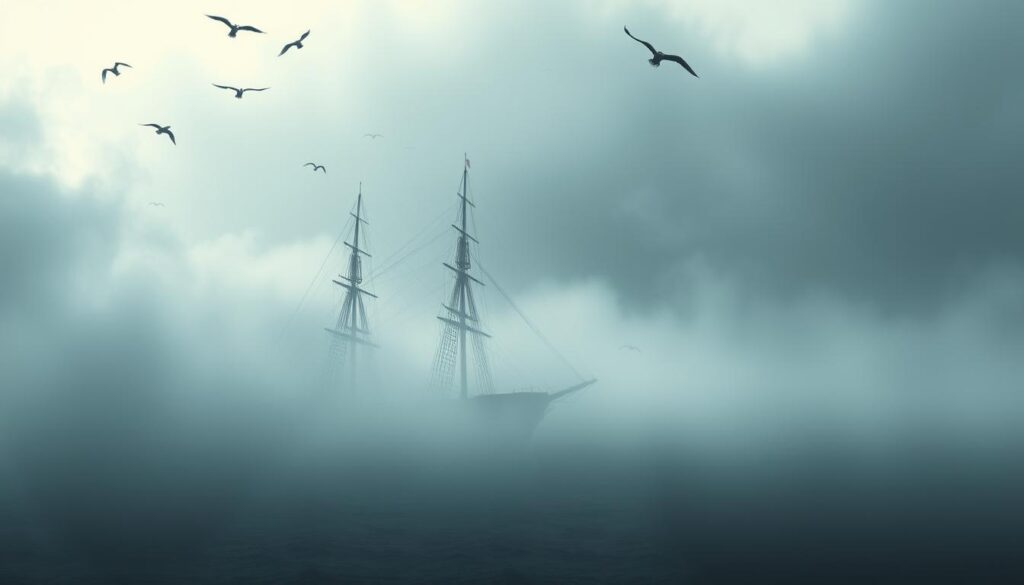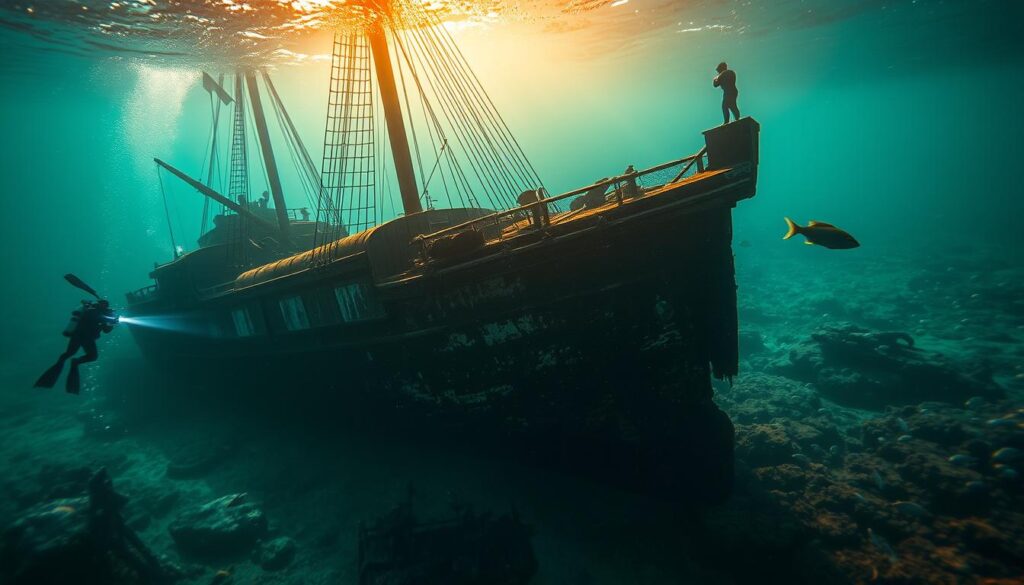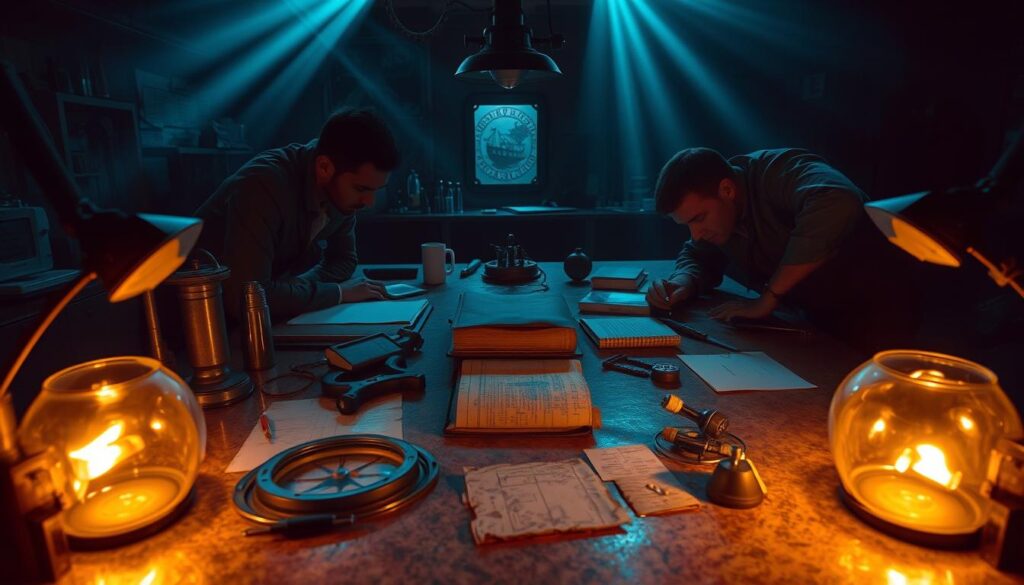Ship Disappears and Returns – The story of a ship that vanished for decades and then reappeared has captured many hearts. It has sparked a lot of curiosity about its disappearance and reappearance. This has left many with unanswered questions.
Such a maritime mystery is rare. When a ship goes missing, it deeply affects the public. It leaves a lasting mark on the maritime world. It also raises many questions about maritime mysteries and being lost at sea.

The tale of the vanishing ship is truly captivating. As we dive into its story, we will uncover the maritime mystery. We will also look at the impact it has on the maritime community.
Key Takeaways Ship Disappears and Returns
- The vanishing ship’s story is a maritime mystery that has sparked intense curiosity and fascination.
- The ship’s disappearance and reappearance have had a profound psychological impact on the public.
- The maritime community has been left with unanswered questions about the events surrounding the ship’s disappearance and reappearance.
- The phenomenon of being lost at sea is a rare occurrence that raises many questions about maritime safety and protocols.
- The story of the vanishing ship is a captivating one that will be explored in detail, including the maritime mystery and the impact on the maritime community.
The Mysterious Voyage That Sparked a Maritime Legend
The ship set sail with a seasoned crew and a cargo full of goods. But, as it ventured further, something was off. The crew’s last messages hinted at trouble, starting a nautical history filled with mystery.
When the ship vanished, it left a sea of questions. What happened to the crew? Did they meet a shipwreck or just disappear? The mystery deepened, making the ship’s story a legend in nautical history.
The ship’s journey was more than just a trip from one place to another. It was a complex adventure influenced by many things. Key factors included:
- Crew dynamics and experience
- Weather conditions and navigation
- Cargo and ship maintenance
These elements were crucial in understanding the ship’s disappearance. They help us unravel the mystery of its voyage.
Looking into the nautical history of the ship’s journey, we learn more about its disappearance. The shipwreck that likely occurred reminds us of the sea’s dangers. It shows how vital preparation is for any journey.
A Ship That Disappears and Returns Decades Later: The Timeline
The story of the ship’s disappearance and return is filled with oceanic phenomena. To grasp what happened, we need a detailed timeline. This timeline will outline major events, investigations, and investigation findings that explain the mystery.
The timeline covers the ship’s departure, last communication, and final sighting. The investigation into its disappearance and return has uncovered key facts. These include the impact of oceanic phenomena on the ship’s journey.
Some major events in the timeline are:
- Initial departure: The ship left its starting port, heading to its destination.
- Last known communication: The ship contacted shore authorities for the last time, sharing its location and status.
- Final sighting: Another ship spotted the missing vessel, reporting its location and status.
- Investigation launched: An investigation into the ship’s disappearance began, involving many agencies and experts.
The investigation showed that oceanic phenomena were crucial in the ship’s disappearance. The ship’s return has given us new insights into its disappearance. It highlights the role of investigation and oceanic phenomena in solving such mysteries.
The Fateful Day of Disappearance
The day the ship vanished has sparked a lot of debate and investigation. To grasp what might have occurred, we need to look at the weather and navigation records from that time. This info helps us understand the ship’s disappearance and its later discovery.
Weather Conditions
The weather on the day of the ship’s disappearance was challenging. There were strong winds and rough seas. These conditions made navigation hard, raising the risk of accidents or maritime law breaches.
Eyewitness Accounts
Nearby vessels saw the ship having trouble staying on course. Yet, no one saw it disappear. These accounts are key to figuring out what happened that day and the discovery years later.
The search for the ship’s disappearance continues. It aims to find out why it happened and its link to maritime law. The discovery of the ship has given us new leads. Experts are now trying to uncover the truth behind its disappearance.
Search and Rescue Operations Through the Years
The maritime mystery of the ship’s disappearance has led to many search and rescue efforts. These operations have been backed by detailed investigation work. They aim to find out what happened to the ship. Groups like the US Coast Guard and other maritime teams have been involved.
Some key search and rescue missions include:
- Initial searches in the 1970s, covering a huge ocean area
- Aerial searches in the 1980s, using the latest radar tech
- Underwater searches in the 1990s, with the help of ROVs
These missions have faced tough challenges, like bad weather and a huge search area. Yet, they’ve found important clues, like debris. These finds have helped us understand what happened to the ship. The investigation is still going on, with new leads being followed.
The search and rescue work has been key in solving the maritime mystery. As the investigation keeps going, we hope to find out the truth. This will bring closure to the families and teach the maritime industry valuable lessons.
| Year | Search Area | Method |
|---|---|---|
| 1970 | North Atlantic | Aerial search |
| 1980 | Caribbean Sea | Underwater search |
| 1990 | Pacific Ocean | Remotely operated vehicle (ROV) search |
Theories Behind the Vanishing Act
Looking into nautical history, we see that ships disappearing at sea has happened many times. Many theories try to explain these vanishings, including the impact of oceanic phenomena. The mix of human actions, scientific studies, and natural events makes these mysteries complex.
Maritime experts look at many factors, like human error and natural disasters. They try to understand what happens in these disappearances. By studying past incidents, they find patterns and possible reasons. This helps them understand how oceanic phenomena affect ships and safety at sea.
- Weather conditions and their potential to affect navigation
- The role of human factors, such as fatigue and error, in maritime accidents
- The impact of scientific advancements on our understanding of oceanic phenomena and their effects on ships at sea
By studying these factors and the history of nautical events, researchers learn more. They understand the complex interactions in these disappearances. This knowledge helps improve maritime safety and lower the risk of such incidents in the future.
The Shocking Reappearance
The story of the ship’s return is full of discovery and mystery. After years lost at sea, it was found remarkably well-preserved. Its location, far from usual paths, made its story even more intriguing.
The team was amazed by the ship’s condition. Despite its age and the sea’s harshness, it was mostly intact. The crew’s unawareness of the disaster before it happened was revealed. This has sparked a lot of interest in the maritime world, with experts wanting to learn more.

Key Findings
- The ship was found with its cargo still intact, which provided valuable insights into the trade routes and commerce of the time.
- The discovery of the ship’s logbook and other documents has shed new light on the events leading up to the ship’s disappearance.
- The discovery of the ship has also sparked a new wave of research into the maritime history of the region, with many experts eager to learn more about the ship and its crew.
The shipwreck is a major find, showing us a lot about the past. It highlights the importance of keeping our maritime history alive. It also shows how curiosity can lead to great discoveries.
Modern Investigation Methods and Results
The search for the ship’s disappearance and reappearance has used new methods. These have brought to light what happened when the vessel was lost at sea. New technology has helped researchers collect and study data better. This has helped them understand what led to the ship’s disappearance.
Some of the modern investigation methods used include:
- Forensic analysis of the ship’s wreckage and debris
- Review of historical weather patterns and navigation records
- Interviews with maritime experts and individuals familiar with the ship’s route
These methods have been key in grasping the impact on maritime law and safety. They show the need for better safety measures to avoid future incidents. The results of these investigations are crucial for the maritime industry. They highlight the importance of ongoing innovation and safety improvements.
The investigation’s findings will lead to changes in maritime law and safety rules. This will help lower the risk of ships being lost at sea. As more information comes to light, it’s clear that modern methods have been vital in solving this maritime mystery.
Physical Evidence and Maritime Forensics
The search for the vanished ship has focused on physical evidence and maritime forensics. Experts have examined the ship’s hull, cargo, and other parts. They look for clues about its disappearance and reappearance.
By studying these clues, experts can understand what happened to the ship. This helps solve the maritime mystery.
Experts have used hull analysis and dating to learn about the ship’s age and history. This is key to knowing its past and how it might have vanished. The technological examination of remnants also gives insights into the ship’s last days.

Maritime forensics has been key in solving this mystery. By analyzing evidence and using forensic methods, investigators have pieced together the ship’s last journey. They’ve found out why it disappeared, Ship Disappears and Returns.
This investigation shows how vital maritime safety is. It also points to the need for ongoing innovation in this area.
Key Findings Ship Disappears and Returns
- Physical evidence analysis has revealed significant clues about the ship’s disappearance
- Maritime forensics has played a crucial role in reconstructing the ship’s final voyage
- The investigation has highlighted the importance of maritime safety protocols and innovation
The search for answers is still going on. Experts keep studying evidence and using maritime forensics. As they find more, we’ll learn more about this mystery and how it was solved, Ship Disappears and Returns.
Impact on Maritime Safety Protocols
The disappearance and reappearance of the ship have changed nautical history a lot. They have made us realize how important it is to know about oceanic phenomena. Now, new tracking systems are in place to stop such incidents from happening again, Ship Disappears and Returns.
Some of the key changes include:
- Improved navigation systems to provide more accurate location tracking
- Enhanced communication systems to facilitate timely emergency responses
- Regular maintenance and inspection of ships to ensure seaworthiness
These updates aim to lower the chance of ships vanishing at sea. They also help in responding faster during emergencies. The incident has also led to changes in international maritime law. These changes focus on nautical history and oceanic phenomena to make safety rules better.
By learning from this incident, the maritime industry can keep improving safety rules. Studying oceanic phenomena and its effects on ships is key. It will keep shaping nautical history for many years.
Similar Historical Cases and Patterns
Looking into historical shipwrecks can teach us a lot. By studying similar cases, we can find common causes of shipwrecks. This helps us create better ways to avoid them.
The USS Central America is a great example. It sank in 1857, causing a lot of loss. Found in 1988, its story helped us understand what went wrong. This shows how important it is to study shipwrecks to make the seas safer.
Some common reasons for shipwrecks include: * Mistakes made by people, like wrong turns or not knowing how to use equipment * Nature’s power, like storms or earthquakes * Problems with the ship itself, like broken parts or bad design These issues can lead to a shipwreck. Knowing about them helps us make the seas safer today, Ship Disappears and Returns.
By learning from the past, the maritime world can lower the risk of shipwrecks. This means safer seas and fewer losses. It’s all about saving lives and preventing disasters, Ship Disappears and Returns.
Conclusion: Lessons from the Ghost Ship’s Return
The story of the ship that vanished and then returned has amazed many. It has given us important lessons for the future of maritime safety and lost at sea rules. Ship Disappears and Returns, As we learn more about the ship’s journey, these lessons will help change maritime law and rescue efforts.
This ship’s return shows us the power of never giving up. It proves that the human spirit can overcome even the toughest challenges. Ship Disappears and Returns – This event will make the maritime world better, pushing for new tech, better communication, and more cooperation to keep everyone safe at sea.
FAQ
What happened to the ship that vanished for decades?
Ship Disappears and Returns – The story of the ship that vanished and then reappeared is fascinating. It has sparked many investigations and theories about what happened at sea.
When did the ship’s voyage begin, and what was known about the crew?
The ship set off with a crew on board. We know about its first steps and the crew’s journey. Records and last messages give us clues about what happened next, Ship Disappears and Returns.
What was the timeline of the ship’s disappearance and reappearance?
The story of the Ship Disappears and Returns and reappearance is complex. Official searches and news have helped us understand the events and possible causes.
What were the weather conditions and navigation records on the day of the ship’s disappearance?
The weather and navigation records from that day are important. Eyewitnesses from other ships also shared their experiences, helping us piece together what happened.
How have search and rescue operations evolved over the years?
Over the years, search and rescue efforts have been key. They’ve shown us the challenges and successes in solving this mystery.
What are the theories behind the ship’s vanishing act?
Many theories try to explain the Ship Disappears and Returns. These include natural events, human actions, and scientific studies. Each theory offers a different perspective on the mystery.
How was the ship rediscovered, and what were the initial investigation findings?
The ship’s reappearance was a shock. The location and condition of the ship were key to the investigation. The first findings raised more questions about its Ship Disappears and Returns.
How have modern investigation methods been used to uncover the truth?
New methods, like advanced forensic science, have been used. These efforts have been crucial in understanding what happened to the ship, Ship Disappears and Returns.
What physical evidence and maritime forensics have been examined?
The ship’s remains have been analyzed. This includes studying the hull and technology. These studies have given us important insights into the ship’s fate, Ship Disappears and Returns.
How has this incident impacted maritime safety protocols and international law?
The incident has led to changes in maritime safety. New tracking systems and updates to international law aim to prevent similar incidents and improve safety at sea, Ship Disappears and Returns.
Are there any similar historical cases that provide context for this mystery?
Looking at similar cases of ship disappearances and discoveries helps us understand this mystery. These historical examples offer context and insights into maritime mysteries, Ship Disappears and Returns.
Source link
